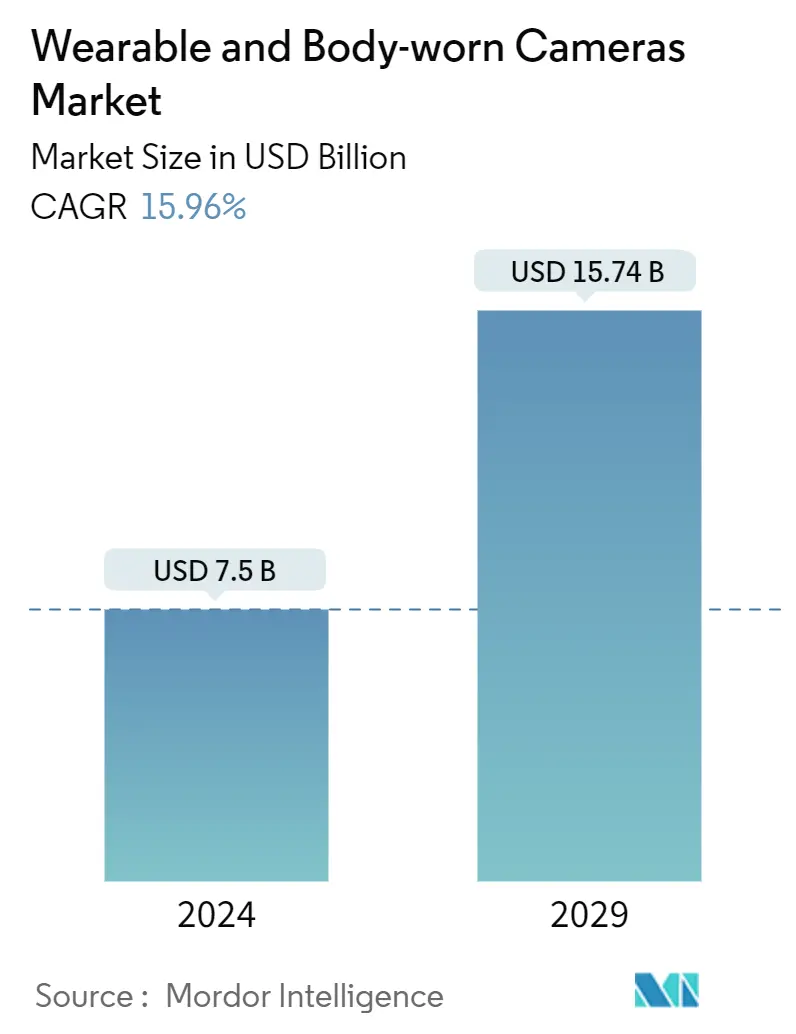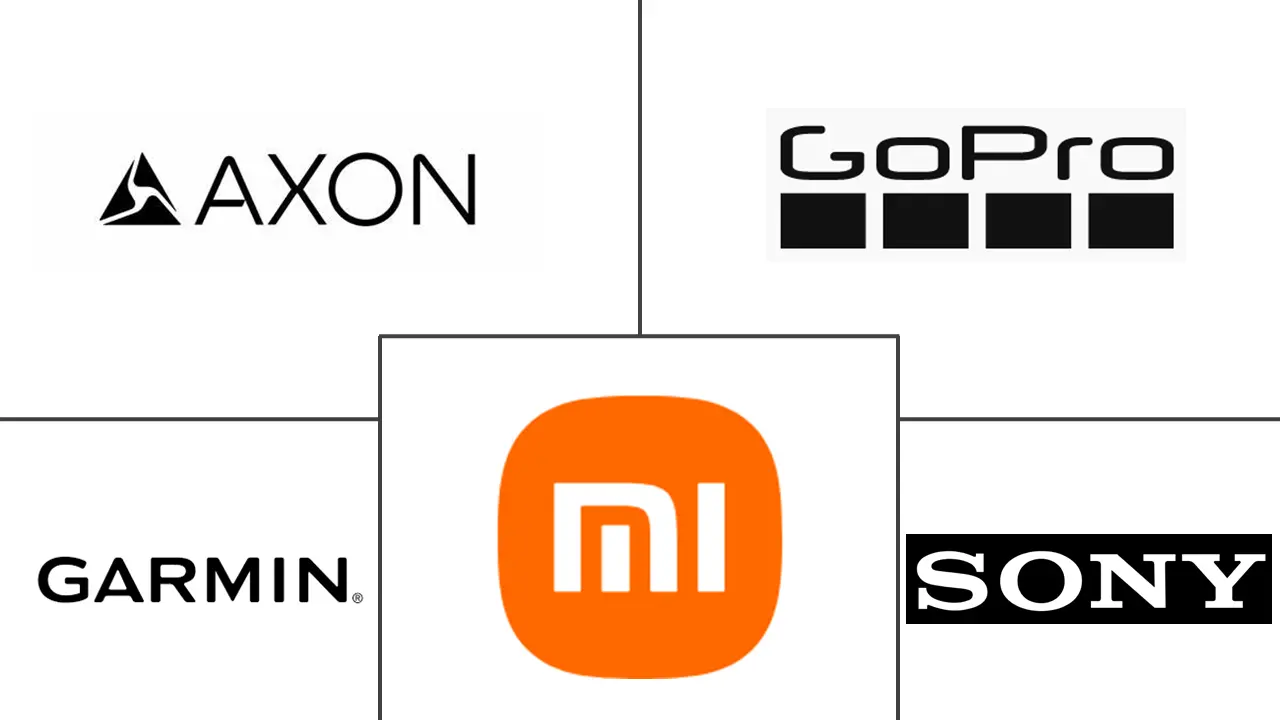Market Size of Wearable And Body-worn Cameras Industry

| Study Period | 2019 - 2029 |
| Market Size (2024) | USD 7.5 Billion |
| Market Size (2029) | USD 15.74 Billion |
| CAGR (2024 - 2029) | 15.96 % |
| Fastest Growing Market | Asia Pacific |
| Largest Market | North America |
| Market Concentration | Low |
Major Players
*Disclaimer: Major Players sorted in no particular order |
Body Worn Camera Market Analysis
The Wearable And Body-worn Cameras Market size is estimated at USD 7.5 billion in 2024, and is expected to reach USD 15.74 billion by 2029, growing at a CAGR of 15.96% during the forecast period (2024-2029).
Wearable technology is a growing trend that incorporates electronic devices into everyday life and can be worn anywhere on the body. The ability to connect to the internet and exchange data between devices and networks is a crucial factor driving the popularity of wearable technology.
- The primary aim of body-worn cameras is to capture an audio and visual record of the occurrences. The camera offers clear vision due to its high-resolution quality. In law enforcement, body-worn cameras (BWCs) are becoming more prevalent, significantly contributing to the market's growth. While the spotlight is on police officers, body cameras are also sought in security-related agreements for airports, colleges, correctional facilities, and private security.
- The use of body cameras improves the transparency of law enforcement operations. They promote and foster confidence between federal agents and the communities they work in. Due to the enormous success of body-worn camera systems, law enforcement and security organizations are approaching a significant shift that will see the widespread adoption of body-worn camera systems.
- They are seen as essential for law enforcement, private security, retail, adventures, and other organizations that require video documentation. With advancing technology, these versatile devices are expected to be used in different industries, leading to promising growth in the global body-worn camera market.
- Furthermore, wearable and body-worn cameras are anticipated to be widely used by those who engage in adventurous sports such as skydiving, bungee jumping, mountain biking, and so on since they are hands-free recording tools that enable users to capture and broadcast a live event or condition. With their hands and eyes free, users may concentrate on the task while the capturing proceeds through the camera users are wearing.
- Although such technology can provide persons falsely accused of crimes with some ways of proving their innocence and protecting police personnel by discouraging inappropriate physical actions, transparency surrounding such material is still debatable.
- In addition to cameras in smartphones, wearable cameras are now being introduced, taking technology to new levels. Companies like Sony and Panasonic are creating camera-equipped glasses and small devices that can be clipped onto clothing, allowing hands-free recording of activities like surfing, snowboarding, and rock climbing. The availability of internet connectivity and high-speed data networks has greatly expanded the capabilities of wearable cameras, leading to increased market penetration in various industries.
- Additionally, activities including camping, climbing, riding, skiing, hiking, and fishing were generally prominent culturally, but COVID-19 increased demand for them and the stakeholders in their respective adventure value networks. In addition to these factors, the growing adoption of advanced technologies in the police category is analyzed to contribute to the market growth rate.
Body Worn Camera Industry Segmentation
Wearable and body-worn cameras are worn by civil servants, police officers, and others to help de-escalate situations, curb police blunders, generate training material, and provide video graphic user device evidence for accurately identifying liable individuals. The increased use of body-worn cameras drives the market because it enable the capture of evidence and real-time data while promoting accountability and transparency in police conduct.
The wearable and body-worn cameras market is segmented by end-users (local police, special law enforcement agencies, sports, and adventure) and geography (North America, Europe, Asia-Pacific, Latin America, Middle East & Africa). The market sizes and forecasts are provided in value (USD) for all the above segments.
| By End User | |
| Local Police | |
| Special Law Enforcement Agencies | |
| Sports and Adventure | |
| Other End Users |
| By Geography | |
| North America | |
| Europe | |
| Asia-Pacific | |
| Latin America | |
| Middle East and Africa |
Wearable And Body-worn Cameras Market Size Summary
The body-worn camera market is experiencing significant growth, driven by the increasing adoption of wearable technology across various sectors. These cameras, which provide high-resolution audio and visual recordings, are becoming essential tools in law enforcement and security, enhancing transparency and accountability. The demand for body-worn cameras is fueled by their ability to foster trust between law enforcement agencies and the communities they serve. As technology advances, these devices are also finding applications in diverse fields such as retail, adventure sports, and private security, contributing to the market's expansion. The integration of internet connectivity and high-speed data networks has further enhanced the capabilities of wearable cameras, leading to broader market penetration.
The competitive landscape of the wearable and body-worn camera market is characterized by the presence of numerous small and large players, with companies like Motorola Solutions, Hytera Communications, and Axon Enterprise leading the charge in product innovation. These companies are continually developing new features and technologies to maintain their competitive edge. Government initiatives and funding in regions like North America are also propelling market growth, as they encourage the adoption of body-worn cameras in law enforcement agencies. The market's fragmentation is evident as players engage in mergers and acquisitions to expand their reach. As the demand for advanced surveillance and documentation tools continues to rise, the body-worn camera market is poised for substantial growth in the coming years.
Wearable And Body-worn Cameras Market Size - Table of Contents
-
1. MARKET INSIGHTS
-
1.1 Market Overview
-
1.2 Industry Attractiveness - Porter's Five Forces Analysis
-
1.2.1 Bargaining Power of Suppliers
-
1.2.2 Bargaining Power of Buyers
-
1.2.3 Threat of New Entrants
-
1.2.4 Threat of Substitutes
-
1.2.5 Intensity of Competitive Rivalry
-
-
1.3 Industry Value Chain Analysis
-
1.4 An Assessment of the Impact of COVID-19 on the Market
-
-
2. MARKET SEGMENTATION
-
2.1 By End User
-
2.1.1 Local Police
-
2.1.2 Special Law Enforcement Agencies
-
2.1.3 Sports and Adventure
-
2.1.4 Other End Users
-
-
2.2 By Geography
-
2.2.1 North America
-
2.2.2 Europe
-
2.2.3 Asia-Pacific
-
2.2.4 Latin America
-
2.2.5 Middle East and Africa
-
-
Wearable And Body-worn Cameras Market Size FAQs
How big is the Wearable and Body-worn Cameras Market?
The Wearable and Body-worn Cameras Market size is expected to reach USD 7.5 billion in 2024 and grow at a CAGR of 15.96% to reach USD 15.74 billion by 2029.
What is the current Wearable and Body-worn Cameras Market size?
In 2024, the Wearable and Body-worn Cameras Market size is expected to reach USD 7.5 billion.

